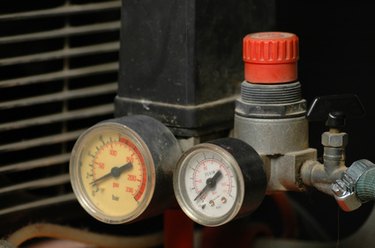
A gas compressor refers to a mechanical device used to increase gas pressure by reducing gas volume. A semi-hermetic compressor refers to a type of sealed compressor.
Types
Video of the Day
Compressor types include open, hermetic and semi-hermetic. These designs are based on how the motor drive and compressor are positioned in relation to the vapor or gas that is compressed. Hermetic compressors are sealed and inaccessible. Semi-hermetic compressors use a metal shell designed with covers that a user can open to replace any damaged or faulty parts, such as pump components or the motor.
Video of the Day
Function
Semi-hermetic compressors raise gas pressure and transport the gas through a piping system for system distribution needs. Electricity energizes the motor, which causes the compressor crankshaft to rotate. The compressor pump contains a piston, which creates a low pressure rear between the piston top and the cylinder head during the downstroke. Gas rushes through a suction valve inlet and into the low pressure area. During the piston upstroke, the suction valve closes, which forces the exhaust valve to open due to increasing pressure. The gas is compressed and forced through discharge, or high pressure side of system.
Cycle
As the semi-hermetic compressor piston reaches the top of the cylinder, the discharge valve closes. The suction valve opens as the piston again starts the downstroke, drawing in gas to complete the cycle.